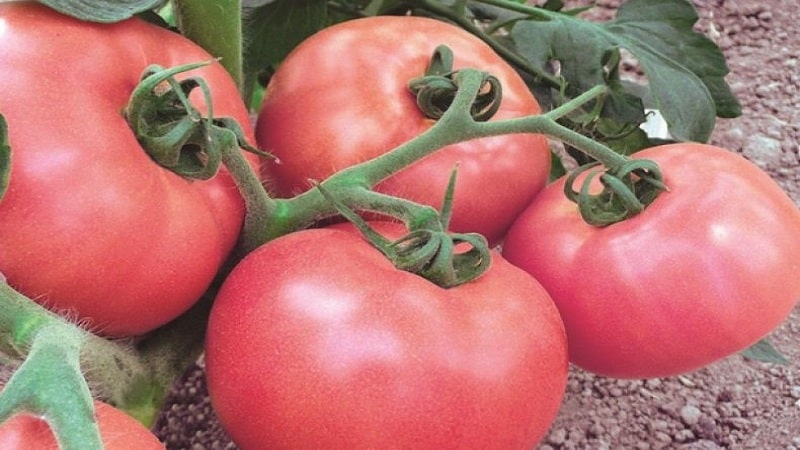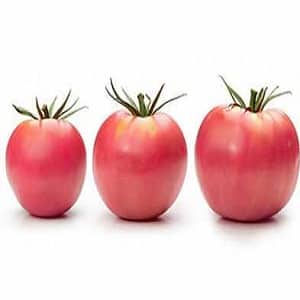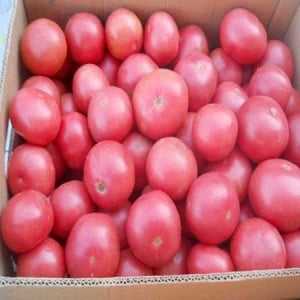Unpretentious and easy to care for, but at the same time spoiling you with a rich harvest, the “Wind Rose” tomato
In a changing climate, there is a need for undemanding vegetable crops. A hybrid tomato called Wind Rose is specially created for areas with changeable weather conditions. Low-growing bushes withstand frost, summer heat and drought.
High yield and excellent taste make the crop popular among farmers and summer residents. In this article we will tell you about the features of growing Windrose tomatoes in open ground and in greenhouses.
Characteristics and description
In the State Register of Plants of the Russian Federation, Windrose tomatoes are described as an early-ripening hybrid intended for cultivation in open ground and in greenhouses under film. Plant determinant (short). Characterized by high productivity.
Distinctive features
The main characteristics of the variety are presented in the table.
| Indicators | Characteristic |
| Weight | The fruits are medium-sized, weighing 140–160 g. |
| Form | Round, with a slight depression in the area of the stalk. |
| Coloring | Unripe fruits are green with a dark green spot in the stalk area. Ripe tomatoes are pink with a pearlescent sheen. |
| Leaves | Medium size with a wavy surface, dark green color. |
| Type of inflorescences | Simple. |
| Pulp | Juicy, but not watery. |
| Taste | Pleasant, sweet. |
| Skin | Smooth, moderately dense. |
| Purpose | Tomatoes are suitable for making salads, juice and canning. |
| Bush height | No more than 0.5 m. |
| Ripening period | It takes 95–97 days from germination to fruit appearance. |
| Productivity | High, as for a low-growing variety - 6-7 kg/m2. |
| Harvesting | From early July to mid-September. |
| Fruiting | Up to 6 tomatoes are formed on one brush. |
| Sustainability | Excellent drought tolerance. |
| Transportability | Tomatoes are stored for a long time and can easily be transported over long distances. |
How to grow seedlings
The growing process involves treatment with growth stimulants, sowing in cups, picking, followed by planting in common pots.

Seed preparation
Since this is a hybrid and not a variety, you won’t be able to collect the seeds yourself. Wind rose is an early ripening crop. But in order for the seeds to wake up faster, they are soaked in a root biostimulator for 12 hours. Then the seed is dried on a paper napkin.
If planting is planned in the northern regions, the seeds are additionally frozen at -10 ° C for 48–72 hours. This increases frost resistance.
Reference. The germination method is used when planting seedlings in a small area to eliminate weak seeds.
Container and soil
The substrate is prepared from equal parts of black soil, sand and humus. Before sowing, the soil is frozen and then pierced in the oven at a temperature of +70 °C. These manipulations disinfect the soil.
Seeds are sown in cups and placed in a well-lit place. Shoots appear at a temperature not lower than +22 °C.
Sowing and caring for seedlings
The seed is distributed into individual paper or plastic cups, 2-3 grains in each. The surface of the soil is sprinkled with sand (layer 5 mm). A plastic film is stretched over the top to create a greenhouse effect. It is removed after the first leaves appear.
The containers are placed in a well-lit place. In cloudy weather, turn on the phytolamp so that the sprouts do not stretch. When 2-3 leaves appear, strong specimens are selected and planted in common containers. This will ensure the development of a strong root system. The seedlings are fed with complex fertilizer and watered if necessary.
Important! Sowing is carried out 50–55 days before the planned planting in the soil.
The second way to obtain seedlings is to sow in mini-greenhouses under film in the first ten days of May. To do this, arcs are made from wire, which are covered with plastic film on top.
Furrows are made in loose soil and boiling water is poured into them. Wait for it to cool, distribute the seeds at a distance of 40 mm and cover with soil mixed with peat. Shoots appear in about 7 days. During this period, carefully monitor the moisture level in the soil and open the film slightly on sunny days.
After the seedlings have grown, begin thinning, leaving gaps between seedlings of 5–7 cm. Chicken manure or saltpeter is used as fertilizer. Loose soil is added to the level of the lower leaves, when the sprouts stretch up to 7 cm. This strengthens the rhizome and makes it possible to get a harvest 2 weeks earlier.
How to cultivate tomatoes
Cultivating tomatoes requires a serious approach. To achieve high yields, it is necessary to follow the rules of sowing, planting and care.
Landing
7 days before planting, the soil is dug up and approvals are made. Seedlings are planted depending on growing conditions:
- To the greenhouse - in the second half of May. The soil should warm up to a temperature not lower than +18 °C.
- In small greenhouses - when the threat of frost returns disappears.
- In open ground - taking into account climatic conditions, at a soil temperature of +15 ° C.
Care
Windrose tomatoes tolerate drought well. However, they need regular watering. Violation of the regime leads to a decrease in yield.
As feeding They use complex products with phosphorus and potassium, bird droppings and mullein. Fertilizers are applied under the rhizome once every two weeks.
Mulching soil after planting with the help of sawdust and pine needles helps prevent the appearance of weeds and insects.
In removing the lateral stepchildren not necessary. The variety belongs to low-growing crops, so it does not need to form a bush.
Garter It is necessary to ensure that the bush can withstand the weight of the fruit.
Possible difficulties
There are no particular difficulties in growing the Wind Rose variety. Tomatoes tolerate sudden weather changes and unfavorable conditions well. However, the crop does not like waterlogging of the soil.
Experienced farmers advise alternating watering with loosening the soil. In dry weather, it is enough to moisten the soil no more than twice a week, and carry out surface loosening in the morning.
Sometimes brown spots appear on tomatoes near the stalk, which indicates a lack of calcium. Feeding with calcium nitrate will help get rid of the problem.
Diseases and pests
The Windrose variety is predisposed to brown rot and brown spot. Timely treatment with chemicals will preserve the harvest.
Experienced farmers recommend treating bushes to prevent late blight. To do this, use a solution of boric acid and increase the dose of fertilizers based on potassium and phosphorus.
If the plant could not be saved from late blight, the affected leaves and fruits are carefully trimmed with scissors and disposed of. The bushes are irrigated with fungicides containing copper oxychloride: “Oxychom”, “Khomom”, copper sulfate. Re-process after two weeks.
To combat aphids, use a warm soapy solution. Ammonia diluted in water will help get rid of slugs.
Insecticides to control spider mites and thrips are used before fruit sets.
Growing in open ground and in a greenhouse
Hybrid Wind Rose is suitable for cultivation in open areas and in greenhouses:
- Seedlings are planted in open ground in early June, maintaining 40 cm between bushes and 60 cm between beds.
- Water with warm water once every seven days.
- To increase productivity, tomatoes are fed with organic matter or combined fertilizers with phosphorus and potassium no more than once every three months.
- The culture loves light and at the same time nutritious soil mixed with peat.
- The seedless planting method is best suited for greenhouse conditions. The wells are pre-treated with a concentrated solution of potassium permanganate and filled with boiling water. Then the seed is planted in the cooled soil and sprinkled.
Harvesting and application

On average, up to 2 kg of fruits are collected from one bush. This is an excellent indicator for determinate plants. Ripe tomatoes acquire a pink tint with a pearlescent tint. Even slightly greenish tomatoes ripen quickly on a well-lit windowsill.
The vegetable has a pleasant sweetish taste and is good fresh or cooked. It is added to salads, baked, juice, sauces, and tomato paste.Medium-sized fruits are used for pickling and pickling. The thick skin does not crack during heat treatment, the tomatoes retain their shape and do not spread.
Advantages and disadvantages
The wind rose stands out against the background of other varieties and hybrids of tomatoes due to the following features:
- The fruits contain many amino acids and beta-carotene. The sweet taste and minimum acidity allow tomatoes to be used for dietary and baby food.
- The plant does not need pinching or bush shaping.
- It is possible to sow directly into the ground without growing seedlings.
- Often does not require additional fertilizing. As practice has shown, only a basic complex fertilizer is sufficient.
- Technical ripening at home makes it possible to collect unripe fruits.
- Gibril is resistant to sudden fluctuations in air temperature.
Disadvantages include the lack of genetic resistance to brown rot and brown spot.
Farmer reviews
Amateur gardeners and experienced farmers have quite contradictory impressions of growing Wind Roses:
Mikhail, Liski: «Several years ago I tried to grow the Wind Rose hybrid at the dacha. In practice, it turned out that the information indicated on the packaging was not true. I followed the recommendations for sowing and planting seedlings, applied fertilizers, and watered them on time. But the leaves were constantly covered with brown spots and dried out. As a result, I collected about two kilograms from five bushes over the entire period.”
Olga, Saratov: “I bought the beautiful picture and the manufacturer’s promises and decided to plant Windrose tomatoes. She looked after the bushes meticulously - watered them, fertilized them, tied them up.As a result, the weight of the fruit did not reach 100 g, the yield per bush was small, but the taste was excellent.”
Vadim, Kaluga: “I have been growing Wind Rose for several years in a row in a greenhouse. I'm happy with the result; I've never had any problems. I periodically irrigate with a solution of copper sulfate to prevent late blight. Tomatoes are tasty, sweet and meaty. The yield is average, the weight of the fruit is from 90 to 120 g. We eat it fresh and marinate with vinegar.”
Conclusion
Hybrid Windrose is characterized by low maintenance. Compliance with the rules of sowing, growing seedlings and cultivating in open areas or in greenhouses allows you to harvest until mid-September. Juicy, fleshy tomatoes are suitable for fresh consumption and canning.